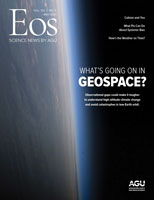In our May issue of Eos, we are looking up at a region of Earth’s atmosphere, the scientists in these pages argue, that we aren’t looking at quite enough. That region is called geospace, which encompasses the mesosphere and the thermosphere from altitudes of around 45 to 1,000 kilometers.
In “An Observational Gap at the Edge of Space,” Martin Mlynczak and colleagues write about how geospace is sensitive to changes in carbon dioxide. Some research has already shown that effects from climate change are changing the density of geospace and thus aerodynamic drag in this “atmospheric borderland” where satellites orbit. Although there are missions observing this region right now, most are past their design lifetimes and have no successors, leaving a looming gap.
Sean Bruinsma and colleagues go into more detail about the consequences to the ever more populated low Earth orbital paths in “Charting Satellite Courses in a Crowded Thermosphere.” “Despite progress made over the past couple of decades, large uncertainties still exist in estimates of the solar, magnetospheric, and gravity wave energy input to—and thus in how this energy affects—the thermosphere,” write the authors, who suggest that a geospace-focused study be commissioned in time for the next heliophysics decadal survey.
Could one solution for the data gap be…ham radio? One group called the Ham Radio Science Citizen Investigation, or HamSCI, is harnessing access to inexpensive, open-source instrumentation along with their passionate, global community to create usable data sets for researchers. The group is particularly focused on the ionosphere, the layer of geospace that reflects radio waves, and how it experiences variability that affects the propagation of those signals. This work may not replace the real-time, continuous observations that space missions can provide, but it is already contributing to research. Read more from Kristina Collins and colleagues in “Ham Radio Forms a Planet-Sized Space Weather Network.”
In another wonderful story about nonscientists providing important data to researchers, read about auroral “dunes.” A group of amateur astronomers in Finland had gathered online to celebrate a new book featuring their photography when one of them saw peculiar green stripes in the sky—3 years to the day since the group had last seen this auroral phenomenon. The club members are now collaborating with researchers to use the observations of the unusual structure of the dunes to study this part of the upper mesosphere where they occur.
Finally, be sure to take a Braque break. When glaciologist Donovan Dennis told us he wanted to write about “Cubist Geomorphology: Your Kinship with Picasso, Explained,” we were excited to read his unusual take. He reminds us that “this Cubist example is one of many possible comparing the intellectual endeavors of artists and geoscientists and demonstrates the long-observed belief that both disciplines stand to strongly benefit from each other.”
—Heather Goss (@heathermg), Editor in Chief, Eos
Citation:
Goss, H. (2021), Paying attention to the “ignorosphere”, Eos, 102, https://doi.org/10.1029/2021EO157418. Published on 22 April 2021.
Text © 2021. AGU. CC BY-NC-ND 3.0
Except where otherwise noted, images are subject to copyright. Any reuse without express permission from the copyright owner is prohibited.


